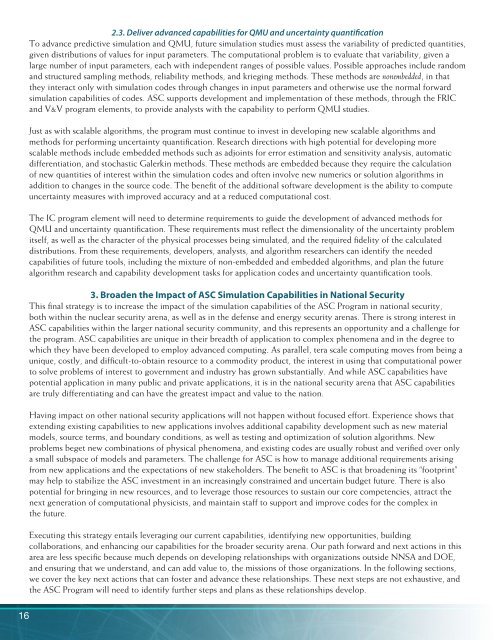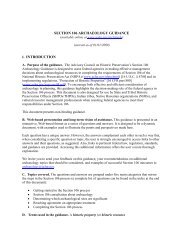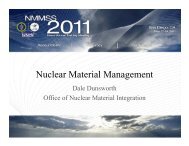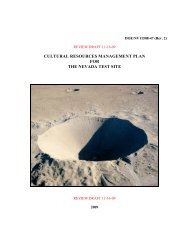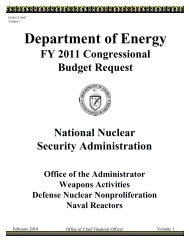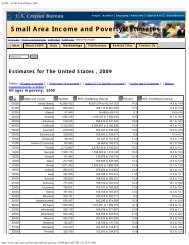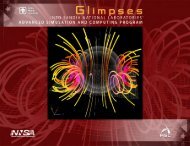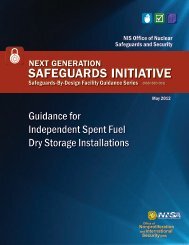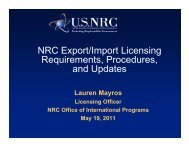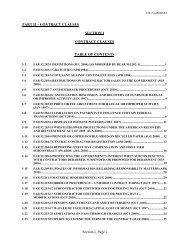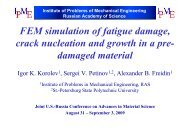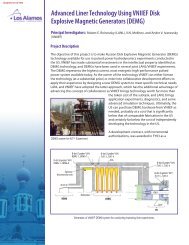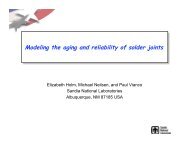ASC Code Strategy - National Nuclear Security Administration
ASC Code Strategy - National Nuclear Security Administration
ASC Code Strategy - National Nuclear Security Administration
Create successful ePaper yourself
Turn your PDF publications into a flip-book with our unique Google optimized e-Paper software.
2.3. Deliver advanced capabilities for QMU and uncertainty quantification<br />
To advance predictive simulation and QMU, future simulation studies must assess the variability of predicted quantities,<br />
given distributions of values for input parameters. The computational problem is to evaluate that variability, given a<br />
large number of input parameters, each with independent ranges of possible values. Possible approaches include random<br />
and structured sampling methods, reliability methods, and krieging methods. These methods are nonembedded, in that<br />
they interact only with simulation codes through changes in input parameters and otherwise use the normal forward<br />
simulation capabilities of codes. <strong>ASC</strong> supports development and implementation of these methods, through the FRIC<br />
and V&V program elements, to provide analysts with the capability to perform QMU studies.<br />
Just as with scalable algorithms, the program must continue to invest in developing new scalable algorithms and<br />
methods for performing uncertainty quantification. Research directions with high potential for developing more<br />
scalable methods include embedded methods such as adjoints for error estimation and sensitivity analysis, automatic<br />
differentiation, and stochastic Galerkin methods. These methods are embedded because they require the calculation<br />
of new quantities of interest within the simulation codes and often involve new numerics or solution algorithms in<br />
addition to changes in the source code. The benefit of the additional software development is the ability to compute<br />
uncertainty measures with improved accuracy and at a reduced computational cost.<br />
The IC program element will need to determine requirements to guide the development of advanced methods for<br />
QMU and uncertainty quantification. These requirements must reflect the dimensionality of the uncertainty problem<br />
itself, as well as the character of the physical processes being simulated, and the required fidelity of the calculated<br />
distributions. From these requirements, developers, analysts, and algorithm researchers can identify the needed<br />
capabilities of future tools, including the mixture of non-embedded and embedded algorithms, and plan the future<br />
algorithm research and capability development tasks for application codes and uncertainty quantification tools.<br />
3. Broaden the Impact of <strong>ASC</strong> Simulation Capabilities in <strong>National</strong> <strong>Security</strong><br />
This final strategy is to increase the impact of the simulation capabilities of the <strong>ASC</strong> Program in national security,<br />
both within the nuclear security arena, as well as in the defense and energy security arenas. There is strong interest in<br />
<strong>ASC</strong> capabilities within the larger national security community, and this represents an opportunity and a challenge for<br />
the program. <strong>ASC</strong> capabilities are unique in their breadth of application to complex phenomena and in the degree to<br />
which they have been developed to employ advanced computing. As parallel, tera scale computing moves from being a<br />
unique, costly, and difficult-to-obtain resource to a commodity product, the interest in using that computational power<br />
to solve problems of interest to government and industry has grown substantially. And while <strong>ASC</strong> capabilities have<br />
potential application in many public and private applications, it is in the national security arena that <strong>ASC</strong> capabilities<br />
are truly differentiating and can have the greatest impact and value to the nation.<br />
Having impact on other national security applications will not happen without focused effort. Experience shows that<br />
extending existing capabilities to new applications involves additional capability development such as new material<br />
models, source terms, and boundary conditions, as well as testing and optimization of solution algorithms. New<br />
problems beget new combinations of physical phenomena, and existing codes are usually robust and verified over only<br />
a small subspace of models and parameters. The challenge for <strong>ASC</strong> is how to manage additional requirements arising<br />
from new applications and the expectations of new stakeholders. The benefit to <strong>ASC</strong> is that broadening its “footprint”<br />
may help to stabilize the <strong>ASC</strong> investment in an increasingly constrained and uncertain budget future. There is also<br />
potential for bringing in new resources, and to leverage those resources to sustain our core competencies, attract the<br />
next generation of computational physicists, and maintain staff to support and improve codes for the complex in<br />
the future.<br />
Executing this strategy entails leveraging our current capabilities, identifying new opportunities, building<br />
collaborations, and enhancing our capabilities for the broader security arena. Our path forward and next actions in this<br />
area are less specific because much depends on developing relationships with organizations outside NNSA and DOE,<br />
and ensuring that we understand, and can add value to, the missions of those organizations. In the following sections,<br />
we cover the key next actions that can foster and advance these relationships. These next steps are not exhaustive, and<br />
the <strong>ASC</strong> Program will need to identify further steps and plans as these relationships develop.<br />
16


